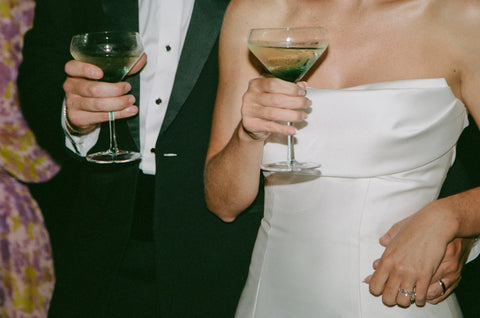The bow tie—a small accessory that has the power to transform a standard suit into something distinctive and memorable. This compact piece of neckwear has evolved from its historical origins to become a statement piece for the style-conscious modern man who wants to stand out from the crowd of traditional necktie wearers.
Our guide will walk you through everything you need to know—from choosing between a bow tie and necktie, to mastering the perfect knot, to pairing your bow tie flawlessly with various suit styles. By the end, you'll have all the expertise needed to wear this classic accessory with confidence and style.
Table of Contents
Bow Tie vs. Necktie: Making the Right Choice
The choice between a bow tie and a necktie isn't merely aesthetic—it's a decision that communicates something specific about your personal style and the nature of the event you're attending.
Formality Spectrum
While bow ties are often associated with formal attire, they can work across a surprisingly wide range of suit-appropriate occasions:
| Aspect | Bow Tie | Necktie |
|---|---|---|
| Visual Impact | Bold, immediate statement | More subtle expression |
| Perceived Style | Distinguished, sometimes academic or creative | Conventional, business-appropriate |
| Versatility | More distinctive, conversation-starter | Extremely versatile |
| Ease of Wearing | Requires practice to tie | Generally easier to master |
| Suit Pairing | Works best with tailored, well-fitted suits | Works with virtually all suit styles |
Face Shape Considerations
Your face shape can influence which tie style complements your features best:
- Round Faces: Bow ties add structure and draw attention to the center of your face, creating a balancing effect.
- Long Faces: The horizontal line of a bow tie can help visually shorten a long face.
- Square Faces: Both styles work well, though wider bow ties can soften angular jawlines.
- Oval Faces: The most versatile shape—both bow ties and neckties work equally well.
Occasion Appropriateness
Different settings call for different tie choices with your suit:
- Weddings: Excellent choice for grooms looking to distinguish themselves from groomsmen
- Business Settings: Works well in creative industries, academia, or law (particularly in the South)
- Creative Professional Events: Perfect for making a memorable impression
- Smart Casual Events: Can dress up a suit worn in a more relaxed way (open collar, no pocket square)
- Seasonal Celebrations: Festive bow ties work wonderfully for holiday parties
The key to making your choice is understanding the context. When in doubt, a necktie is usually the safer option, but a bow tie makes a more distinctive statement when the occasion permits.
Types of Bow Ties
Not all bow ties are created equal. Understanding the different types will help you make informed decisions about which style best suits your needs and aesthetic preferences when wearing one with a suit.
Construction Methods
Self-Tie (Freestyle)
The traditional and most respected form of bow tie, requiring the wearer to tie it himself. These bow ties consist of a single piece of fabric that you must knot yourself, similar to tying your shoelaces but with a different technique.
Advantages:
- Most authentic and elegant option
- Develops a personalized, slightly imperfect knot that adds character
- Demonstrates attention to detail and sartorial knowledge
Disadvantages:
- Requires practice to master
- May need adjustment throughout an event
Pre-Tied
A bow tie that comes already knotted with an adjustable neck strap.
Advantages:
- Convenient and consistent look
- No tying skills required
- Stays perfectly shaped all day
Disadvantages:
- Lacks the subtle imperfections that give self-tie bow ties character
- Often recognizable as pre-tied to the discerning eye
- Less respected in formal circles
Clip-On
Attached by a metal clip directly to the collar of your shirt.
Advantages:
- Extremely easy to use
- Good for young boys or those with dexterity issues
Disadvantages:
- Often sits awkwardly on the collar
- Generally not recommended for adults in formal settings
Bow Tie Shapes

Butterfly (Standard)
The classic and most common bow tie shape, featuring ends that flare out like a butterfly's wings. This traditional shape works well with most suit styles and is the most versatile option.

Batwing (Straight)
A slim, rectangular shape that creates a more contemporary, streamlined look. Also called a "straight" bow tie, this style pairs excellently with modern, slim-cut suits.

Diamond Point
Features pointed ends rather than flat ones, creating an asymmetrical look when tied. This distinctive style adds visual interest and pairs well with textured suit fabrics like tweed or flannel.
Rounded Club
Has rounded ends for a softer appearance. This less common style offers a unique look that works particularly well with suits featuring softer shoulders and less structured silhouettes.
Fabric Choices
The material of your bow tie significantly impacts how formal it appears and how well it pairs with different suit fabrics:
Silk
Classic, refined option with a subtle sheen. Perfect for wool suits in professional or elegant settings. Works year-round and transitions well from day to evening.
Cotton
More casual, ideal for daytime events. Pairs beautifully with cotton, linen, or lightweight wool suits. Great for spring and summer occasions.
Wool or Wool Blends
Excellent for fall and winter. Complements heavier wool, tweed, or flannel suits. Adds texture and visual interest to cold-weather ensembles.

Linen
Extremely lightweight for hot weather. Perfect match for linen or lightweight cotton suits. Ideal for summer daytime events or destination weddings.

Velvet
Rich texture ideal for special occasions. Creates a striking contrast with wool suits. Best for evening events in cooler months.
How to Tie a Bow Tie: Step-by-Step Guide
Mastering the art of tying a bow tie is a skill worth acquiring. While it may seem intimidating at first, with practice, it becomes second nature. Here's a detailed breakdown of the process:
Before You Begin
- Stand in front of a mirror
- Start with the bow tie flat around your neck, right side extending about 1.5 inches lower than the left
- Ensure your collar is up and the bow tie is placed against your neck, not your collar
Step-by-Step Instructions
-
Cross the longer end over the shorter end
- Create an X-shape at the center of your neck
- The longer end should now be on your left side
-
Loop the longer end up through the neck loop
- Pull it completely through
- Tighten gently to create the center knot base
-
Fold the shorter end horizontally
- This creates the front loop of your bow tie
- Hold this horizontal fold in place with your index finger
-
Drape the longer end over the center of the front loop
- This will form the visible knot of your bow tie
- The longer end should hang down over the front of the horizontal fold
-
Create a new fold with the hanging end
- Fold it back toward your chest, creating another horizontal fold
- This will be the back loop of your bow tie
-
Push this new fold through the loop behind the front loop
- You'll need to find the small opening behind the front loop
- This is often the trickiest part of the process
-
Pull both ends to tighten and adjust
- Gently pull the folded parts (not the ends) to tighten
- Adjust until the sides are even (slight imperfections add character)
Common Mistakes to Avoid
- Starting with uneven lengths: The right side should be just slightly longer than the left
- Overtightening the initial knot: Keep it snug but not tight, as you'll need flexibility
- Pulling the ends instead of the loops when tightening: This distorts the shape
- Making it too perfect: A slight asymmetry is the hallmark of a hand-tied bow tie
- Ignoring proportion: Your bow tie width should roughly align with the width of your face and suit lapels
Expert Tips
- Practice at least 5-10 times before an important event
- If you're struggling, try practicing with the bow tie around your thigh first, where you can see better
- The final bow tie should be roughly the same width as your eyes
- A properly tied bow tie sits flat against your collar without sagging
- Keep adjustments minimal once tied—too much fiddling looks fussy
When to Wear a Bow Tie with Your Suit
Understanding the appropriate occasions for pairing a bow tie with your suit is essential for making a positive style impression. Here's a breakdown of when a bow tie is appropriate, expected, or a stylish option:
Special Occasions
Weddings
A distinctive way for grooms to set themselves apart. Consider a bow tie in a signature color that complements wedding themes. Creates a classic, photogenic look that ages well in wedding albums. Can help distinguish family members from other guests.
Milestone Celebrations
Anniversary parties, retirement celebrations, award ceremonies, and charity galas are all excellent opportunities for bow ties. For these events, a well-chosen bow tie with your suit signals the special nature of the occasion without requiring more formal attire.
Professional Settings
In most corporate environments, neckties remain the standard. However, bow ties can work well with suits in creative industries (advertising, design, media), academic settings (professors, administrators), medical professions (particularly for specialists), legal settings (especially in southern states), and architecture and design fields.
The key is understanding your workplace culture. When bow ties align with your industry or company's style, they can set you apart as a confident, detail-oriented professional.
Seasonal Events
Certain times of year naturally lend themselves to bow tie styling with suits. Spring and summer events like garden parties, outdoor weddings, graduation ceremonies, and horse racing events offer perfect opportunities for bow ties with lighter-colored suits.
Fall and winter occasions such as holiday parties, theater premieres, museum openings, and winter weddings provide excellent settings for bow ties in richer textures and deeper colors that complement seasonal suiting.
Smart Casual Settings
Increasingly, bow ties are finding their place in smart-casual suit styling for dinner dates at upscale restaurants, gallery openings, cocktail parties, and live performances.
For these occasions, consider pairing your bow tie with a suit worn without a pocket square for balance, a suit with the jacket sleeves slightly rolled, a suit jacket with more casual pants for a mixed approach, or a textured suit in a less formal fabric like cotton or lightweight wool.
How to Match a Bow Tie with Your Suit
Creating harmony between your bow tie and suit requires understanding a few key principles of color theory, pattern coordination, and proportion.
Color Coordination
The color of your bow tie should complement—not exactly match—your suit and shirt. Consider these guidelines:
For Navy Suits
Burgundy or maroon creates a rich complement. Yellow or gold offers high contrast. Pink provides a softer complement. Navy creates monochromatic sophistication (ensure different textures).
For Grey Suits (Light to Charcoal)
Purple adds regal sophistication. Blue in various shades works beautifully. Red creates classic contrast. Green (particularly emerald) offers distinction.
For Blue Suits (Royal to Lighter Blues)
Orange or coral creates a striking complement. Darker blues for subtle sophistication. Silver or grey for an elegant monochromatic look. Deep red for classic pairing.
For Earth Tone Suits (Brown, Tan, Olive)
Forest green emphasizes the natural palette. Burnt orange or rust creates harmony. Navy provides elegant contrast. Burgundy offers rich coordination.
For Black Suits
Silver or grey for elegant simplicity. Jewel tones for sophisticated pop. Black for classic monochromatic styling. White for maximum contrast (with appropriate occasions).
Pattern Matching Guidelines
Mixing patterns requires attention to scale and type to create a harmonious look. The scale rule is straightforward: if you're wearing a patterned suit or shirt, your bow tie pattern should be of a different scale. For instance, pair a fine-striped shirt with a bow tie featuring larger polka dots or a bold plaid to create visual interest without competition.
The type rule suggests mixing different pattern types rather than different scales of the same pattern. Stripes and dots create a classic combination, while checks and florals offer a more adventurous pairing. When in doubt, pairing a solid-colored element with any pattern is the safest approach for a polished look.
Pay attention to density balance as well. If one element of your outfit has a busy pattern, keep others more subdued. A subtle pindot suit provides the perfect backdrop for a bolder bow tie pattern, while a statement-check suit calls for a more restrained bow tie that doesn't compete for attention.
Seasonal Considerations
Adapt your bow tie to the season for appropriate styling with your suit. Spring and summer call for lighter colors and fabrics, with cotton and linen materials taking center stage. This is the perfect time to incorporate floral patterns, pastels, and summer-friendly fabrics like madras and seersucker that complement the lighter weight suits of the season.
Fall and winter, by contrast, welcome deeper, richer colors and heartier textures. Wool and velvet bow ties bring warmth and dimension to cold-weather ensembles, while plaids, paisley patterns, and jewel tones harmonize beautifully with the heavier suits typical of the season. These thoughtful seasonal selections ensure your bow tie feels appropriate regardless of when you're wearing it.
Accessory Coordination
Your bow tie should harmonize with other accessories paired with your suit to create a cohesive look. Pocket squares should complement, not exactly match your bow tie. If your bow tie features a pattern, select a pocket square that incorporates a color from that pattern while introducing its own distinctive design. For maximum sophistication, coordinate the colors but differentiate the materials—perhaps a silk bow tie with a linen or cotton pocket square.
Metal accessories should maintain consistency throughout your ensemble. Your cufflinks should align with other metal elements like your watch, belt buckle, or tie bar. These pieces can echo a color or theme from your bow tie while maintaining their own identity. In business settings, simple, elegant metal cufflinks provide the perfect finishing touch without overwhelming your bow tie.
If you opt for suspenders, ensure they work tonally with your bow tie while avoiding exact matching, which can appear contrived. Consider creating texture contrasts, such as pairing a smooth silk bow tie with textured suspenders for visual interest. Finally, your watch should harmonize with the overall formality of your suit and bow tie combination, with leather straps that echo your shoes for a thoughtfully coordinated appearance.
Expert Styling Tips from The Black Tux
After dressing countless clients for important occasions, our stylists have developed insights that can help you perfect your bow tie and suit combination:
Proportion is Key
The width of your bow tie should generally correspond to the width of your face and suit lapels. A large butterfly bow tie can overwhelm a narrow face or thin lapels, while a skinny batwing might look insubstantial with wide lapels or a broader face.
Consider Your Suit's Structure
Structured, sharp-shouldered suits pair well with clean-lined bow ties like the batwing. Softer, more natural-shouldered suits complement the butterfly or diamond point styles. The bow tie should feel like it belongs with the overall silhouette of your suit.
Mind the Collar
Bow ties pair best with specific collar types. Point collars are the most versatile option. Spread collars create a nice frame for the bow tie. Button-down collars are generally avoided with bow ties in more formal settings, but can work for casual events.
Suit Fabric Matters
The texture of your suit should inform your bow tie choice. Smooth worsted wool suits create a pleasing contrast with silk bow ties. Textured suits (tweed, flannel) pair well with textured bow ties like wool or cotton. Lightweight summer suits maintain a seasonal feel with linen or cotton bow ties.
Current Trends Worth Considering
The world of bow ties continues to evolve with fresh interpretations worth exploring. Texture mixing has become increasingly popular, with velvet bow ties creating rich contrast against traditional wool suits. Monochromatic styling—like pairing a navy bow tie with a navy suit in different textures—offers a sophisticated approach that's both modern and timeless. For the warmer months, subtle floral patterns provide a refined way to incorporate seasonal elements, while asymmetrical designs offer a slightly unconventional shape for those creative occasions where you want to make a distinctive impression without being overly flamboyant.
Conclusion
The bow tie occupies a special place in men's style—it's an accessory that signals confidence, attention to detail, and a knack for knots. When paired with the right suit, a bow tie creates a distinctive look that sets you apart from the crowd.
Whether you're preparing for a wedding, important business meeting, or simply looking to distinguish yourself from the necktie-wearing masses, the perfect bow tie awaits. The key is understanding the principles outlined in this guide, then adapting them to your personal style and the specific occasion.
Remember that wearing a bow tie with your suit is as much about attitude as it is about appearance. It requires more confidence than a standard necktie, which is precisely what makes it special. When worn with assurance and tied with care, a bow tie doesn't just complement your suit—it becomes the focal point.
Ready to find your perfect bow tie? Explore our collection for options that range from timeless classics to contemporary standouts, all crafted to help you look your absolute best.









